PSYC2300: Cognitive Psychology (Wk 8-12)
1/129
There's no tags or description
Looks like no tags are added yet.
Name | Mastery | Learn | Test | Matching | Spaced |
|---|
No study sessions yet.
130 Terms
Hierarchical structure of language
Language uses well-defined hierarchical patterns with the highest level being a sentence (contains intended meaning) → phrases → words → morphemes → phonemes. Within each level people can combine units to produce novel units (e.g. phonemes into brand-new morphemes). Often demonstrated through a tree structure.
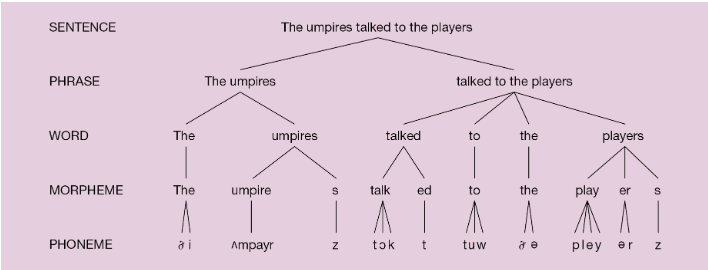
Morpheme
The smallest language unit that carries meaning. Psycholinguists distinguish content (or “free”) morphemes (the primary carriers of meaning) from function (or “bound”) morphemes (which specify the relations among words).
Phoneme
A unit of sound that distinguishes one word (or one morpheme) from another. For example, the words “peg” and “beg” differ in their initial phoneme p and b. Some contrasts in sound not initial phoneme e.g. speaker’s emphasis or regional accent, but they do not change the identity of the words being spoken. (These contrasts are sometimes said to be “subphonemic.”)
Production of speech
Airflow from the lungs → passes through larynx → oral and nasal cavities. Different vowels are created by lip and tongue movement that changes size of oral cavity while consonants are produced by movements that temporarily obstruct vocal tract airflow.
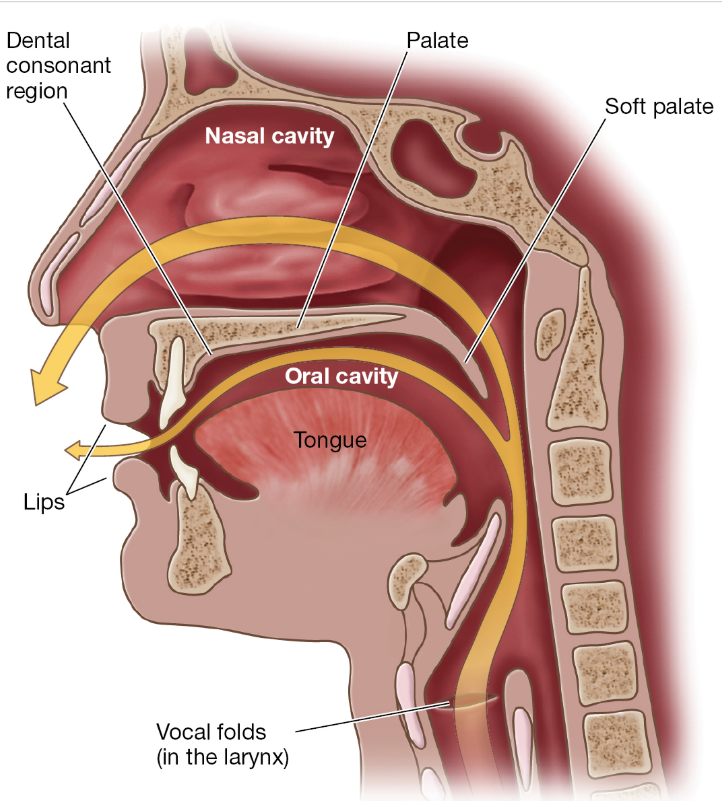
Voicing
Distinguishes different categories of speech sounds. A sound is considered “voiced” if the vocal folds (vocal chords) are vibrating while sound is produced. If the vocal folds start vibrating sometime after the sound begins, the sound is considered “unvoiced.”
Manner of production
The way in which a speaker momentarily obstructs the flow of air out of the lungs to produce a speech sound. For example, the airflow can be fully stopped for a moment, as in the [t] or [b] sound; or the air can continue to flow, as in the pronunciation of [f] or [v].
Place of articulation
The position at which a speaker momentarily obstructs the flow of air out of the lungs to produce a speech sound. For example, the place of articulation for the [b] sound is the lips; the place of articulation for the [d] sound is where the tongue briefly touches the roof of the mouth.
Speech segmentation
The process through which a stream of speech is “sliced” into its constituent words and, within words, into the constituent phonemes. In actuality, there is a constant pattern of amplitude showing that there are no actual pauses between words and we generate our own through segmentation. This is why we perceive foreign languages as being spoken very fast as an uninterrupted flow of sound because we lack to skill of segmentation for their language.
Coarticulation
A sound is altered slightly by the immediately preceding and immediately following sounds. Because of this “overlap” in speech production, the acoustic properties of each speech sound vary according to the context in which that sound occurs. E.g. o in boy vs o in ointment. This means there is no specific acoustical pattern of a sound.
Phonemic restoration effect
A pattern in which people “hear” phonemes that actually are not presented but that are highly likely in that context. For example, if one is presented with the word “legislature” but with the [s] sound replaced by a cough, one is likely to hear the [s] sound anyhow. Linked to the lab experiment we did. This is because people rely on expectations and knowledge (top down processes) to aid speech perception.
Categorical perception
The pattern in which speech sounds are heard “merely” as members of a category. Perceivers are highly sensitive to the acoustic contrasts that distinguish sounds in different categories; people are much less sensitive to the acoustic contrasts that distinguish sounds within a category.
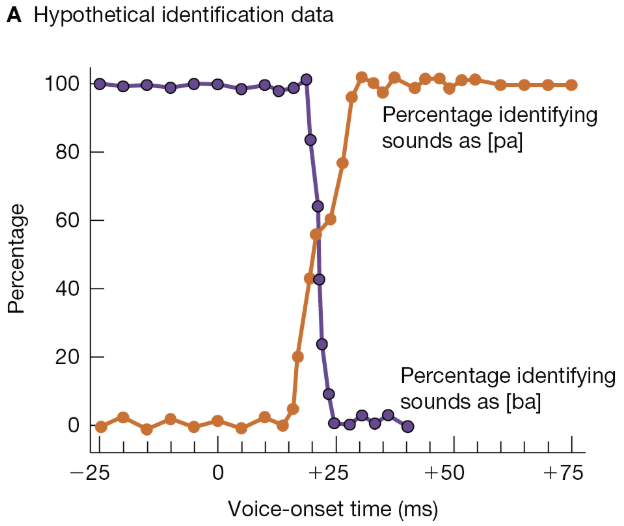
Generatively
The ability to combine and recombine basic units to create new and more complex entities e.g. paleo. Linguistic rules, for example, are generative because they enable a person to combine and recombine a limited set of words to produce a vast number of sentences. Not all combinations are possible due to a set of rules e.g. syntax for sentences and pronunciation of plural endings even in novel cases e.g. wugs (z) ending.
Perceptual information of words
Words sound (sequence of phonemes), orthography (sequence of letters that spell the word), how to use the word within carious phrases (governed by syntax) and the meaning of the word through semantic and phonological representation
Syntax
Rules governing the sequences and combinations of words in the formation of phrases and sentences. Sentences can be grammatically acceptable but lack meaning e.g. colourless green ideas sleep furiously and the Jabberwocky poem. Words can also have meaning but not be well formed syntax-wise e.g. yoda.
Phrase-structure rules
Constraints that govern what elements must be contained within a phrase and, in many languages, what the sequence of those elements must be.
Prescriptive rules
Rules describing how things are supposed to be instead of how they are. Often called “normative rules” and contrasted with descriptive rules. E.g. they can be used as a singular pronoun but people disagree on a prescriptive basis.
Descriptive rules
Rules that simply describe the regularities in a pattern of observations, with no commentary on whether the pattern is “proper,” “correct,” or “desirable.”
Parse
Understanding each words syntactic role to help extract relevant information. Parsing is usually done by figuring out its role as they hear them which is efficient but can lead to errors e.g. garden path sentences. Parsing is guided by the assumption that sentences will be in active voice, the function words and morphemes that signal syntatic role (e.g. -ly and -ed) and background knowledge.
Garden-path sentences
A sentence that initially leads the reader to one understanding of how the sentence’s words are related but then requires a change in this understanding to comprehend the full sentence. Examples are “The old man ships” and “The horse raced past the barn fell.” Utilises temporary ambiguity with early parts having multiple interpretations that are cleared up in the later part of the sentence.
Extralinguistic context
The social and physical setting in which an utterance is encountered; usually, cues within this setting guide the interpretation of the utterance.
Prosody
The pattern of pauses and pitch changes that characterise speech production. Prosody can be used to emphasise elements of a spoken sentence, to highlight the sentence’s intended structure, or to signal the difference between a question and an assertion e.g sol sipped the soda
Pragmatic rules
Principles describing how language is ordinarily used; listeners rely on these principles to guide their interpretation of what they hear. For example, listeners rely on these rules when they interpret the question “Can you pass me the salt?” as a request for the salt, not an inquiry about someone’s arm strength.
Common ground
The set of beliefs/assumptions shared by conversational partners where each person counts on shared background knowledge e.g. piggy bank to making inferences about points not explicitly mentioned in the conversation, and interpret elements of the conversation that would otherwise be unclear or ambiguous. e.g. I’m leaving you → who is he? is an example of soap opera script that relies on additional knowledge
Broca’s area
An area in the left frontal lobe of the brain; damage here typically causes nonfluent aphasia where person loses ability to speak/write with any fluency.
Wernicke’s area
An area in the temporal lobe of the brain, where the temporal and parietal lobes meet; damage here typically causes fluent aphasia where people are able to speak but the speech is not meaningful meaning people are unable to understand them.
Specific-language impairment
A disorder in which individuals seem to have normal intelligence but experience problems in learning the rules of language common in children.
Overregulation error
People produces a form that is consistent with a broad pattern, even though that pattern does not apply to the current utterance e.g. foots, this is very common in children. Or people may perceive/remember a word/event as being closer to the “norm” than it really is. For example, misspelled words are read as though they were spelled correctly; atypical events are misremembered in a way that brings them closer to more-typical events.
Sign language “home sign”
Children who are born deaf but aren’t given the opportunity to learn sign language will invent own gestural language called home sign. This demonstrates that children learn language even if communication with adults is limited. Sign language contains many fundamental properties of language including hierarchical organisation and complex grammar.
Active nature of language learning for children
The ability for children to learn language depends on their environment. Children rely on patterns, prosody, and syntax to understand language and they learn it relatively quickly. Children’s raised in bilingual homes generally learn both languages quite quickly (especially when compared to trying to become bilingual later on)
Wolf children
Children who haven’t been exposed to any human language with many never learning how to use language normally which demonstrates the importance of early language development and the need for a communicative partner (not necessarily an adult/parent however)
Linguistic relativity (Whorfian hypothesis)
The proposal that the language people speak shapes their thought, because the structure and vocabulary of their language create certain ways of thinking about the world. This is dubious.
Alternate proposal to Whorifan hypothesis
More likely than language guides what you pay attention to which shapes your thinking therefore language has an indirect influence that works via attention. Additionally it shows that the effect of language on cognition are easily reversible.
Frequency estimate
An essential step in judgment, in which someone makes an assessment of how often they have experienced or encountered a particular object or event.
Attribute substitution
Person needs one type of information but relies instead on a more accessible form of information which works well if the more accessible form of information is well correlated with the desired information. An example is when someone needs information about how frequent an event is in the world and relies instead on how easily they can think of examples of the event.
Availability heuristic
A particular form of attribute substitution in which the person needs to judge the frequency of a certain type of object or the likelihood of a certain type of event. For this purpose, the person is likely to assess the ease with which examples of the object or event come to mind; this “availability” of examples is then used as an index of frequency or likelihood.
Representativeness heuristic
A strategy that is often used in making judgments about categories. This strategy is broadly equivalent to making the assumption that, in general, the instances of a category will resemble the prototype for that category and, likewise, that the prototype resembles each instance.
Heuristic
A strategy that is reasonably efficient and works most of the time. In using a heuristic, the person is choosing to accept some risk of error in order to gain efficiency.
Attribute substitution: Frequency
You want to judge frequency of occurrences but instead you rely on availability heuristic. This usually works because events that are frequent are likely to be more available in memory. However, it can lead to errors because many other factors influence availability from memory e.g. emotion.
Attribute substitution: Probability
You want to judge the probability of an event in a category or having certain properties but instead you rely on representativeness heuristic. This usually works because many categories are homogenous enough so that category members to resemble one another however many categories aren’t homogenous which leads to errors.
Attribute substitution: risks and benefits
You want to judge the risks and benefits associated with an outcome but instead you rely of the affect heuristic (how does thinking abt outcome make you feel). This usually works bc dangers are often frightening and benefits make you feel good. However, this can lead to error bc level of emotion is influenced by factors that have little connection to likelihood of the outcome.
Attribute substitution: Estimates of value
You want to judge estimates of value but instead you rely on the effort heuristic (how much effort did you have to spend) which usually works bc it takes more work to obtain things of higher value. However this can lead to errors when value is independent of effort e.g. earning vs finding $20
Covariation
A relationship between two variables such that the presence (or magnitude) of one variable can be predicted from the presence (or magnitude) of the other. Covariation can be positive or negative. If it is positive, then increases in one variable occur when increases in the other occur. If it is negative, then decreases in one variable occur when increases in the other occur.
Confirmation bias
People are more sensitive to evidence that confirms their beliefs than evidence that challenges their beliefs. People therefore seek information that confirms beliefs and if presented with both confirming and disconfirming evidence, they’re more likely to pay attention to, be influenced by, and remember the confirming evidence, rather than the disconfirming.
Base rate information
Information about the broad likelihood of a particular type of event (also referred to as “prior probability”). Despite the importance of base rates people often ignore them (unless it is the only info available) and use diagnostic information even when both info is available.
Diagnostic information
Descriptions about a particular case that is often crafted based on common stereotypes. Diagnostic information is often less reliable
Illusions of covariation
People often detect covariation when there is none e.g. zodiac signs. This is partly because the person feels well served by their belief meaning they only consider a subset of facts about the relationship that is skewed by expectation which is often linked to confirmation bias
Dual proces model
Any model of thinking that claims people have two distinct means of making judgments—one of which is fast, efficient, but prone to error (type I thinking/heuristics), and one that is slower, more effortful, but also more accurate (type II thinking/normative)
Sophistication of type I thinking
Type I thinking can be sophisticated when base-rate information is conveyed in frequency terms, if the role of random chance is prominent in a problem, based on education (e.g. statistics class), and resisting the obvious answer (cognitive reflection test)
Cognitive reflection test
A test that measures peoples ability to resist the obvious answer to a question and think about why the obvious answer might be wrong. People who do well on the CRT are less prone to judgement errors.
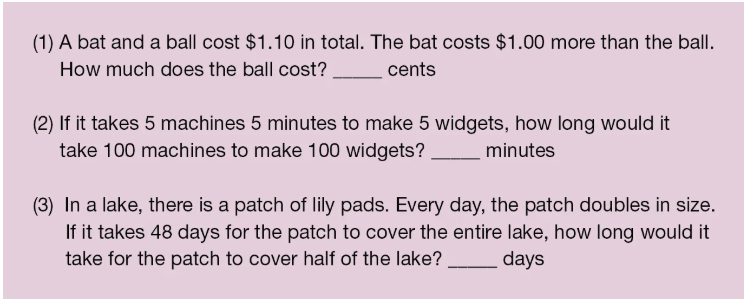
Induction
A pattern of reasoning in which a person seeks to draw general claims from specific bits of evidence. Often contrasted with deduction.
Deduction
A process through which a person starts with claims, or general assertions, and asks what further claims necessarily follow from these premises. Often contrasted with induction.
Belief perseverance
A tendency to continue endorsing some assertion or claim, even when the clearly available evidence completely undermines that claim.
Different effects within confirmation bias
People assess belief/hypothesis and are more likely to seek evidence that confirms belief
When disconfirming evidence is made available ppl don’t adjust their beliefs
When people encounter confirming evidence they take it at face value while they are more skeptical of disconfirming evidence
People have better memory for confirming evidence and distort disconfirming evidence
People fail yo consider alternative hypotheses
Categorical syllogisms
A logical argument similair to a conditional statement that contains two premises and a conclusion about relationships between categories. They are valid if the conclusion does follow the premise and vice versa.
Valid syllogisms = All M are B, All D are M, therefore all D are B AND all X are Y, some A are X therefore some A are Y
Invalid syllogisms = All P are M, All S are M, therefore all S are P
We are really bad at syllogism reasoning bc our strategies are not based in logic.
Belief bias
Endorsing a conclusion if the conclusion happens to be something one believes is true anyhow. In displaying this tendency, people seem to ignore both the premises of the logical argument and logic itself, and they rely instead on their broader pattern of beliefs about what is true and what is not.
Selection task (four-card task)
Task where participant is presented with four cards with certain information on either side of the card. The person is also given a rule that may describe the cards, and the person’s task is to decide which cards must be turned over to find out if the rule describes the cards or not. People are often bad at this however this is dependent on the content.
Selection task (four-card task) examples
Rule: If a card has a vowel on one side, it must have an even number on the other side
Cards: A 6 J 7
Answer: A and 7
Rule: If a person is drinking beer, then the person must be at least 21 years old.
Cards: Drinking beer, 22 yrs, drinking coke, 16 yrs
Answer: drinking beer and 16 years of age
Utility maximisation
The proposal that people make decisions by selecting the option that has the greatest utility.
Framing
How the options or the decision is framed which determines whether the decision is cast in terms of gains/positive attributes or losses/negative attributes
Risk seeking vs risk aversion
Seeking = people tend to be risk seeking when contemplating losses bc they are willing to gamble to avoid losses
Aversion = people tend to be risk averse when contemplating gains bc they want to maintain what they already have
Reason-base choice
An alternate proposal to utility maximisation where people make decisions based on what we feel good about and that we think is reasonable and justified.
Somatic markers
States of the body used in decision making. For example, a tight stomach and an accelerated heart rate when a person is thinking about a particular option can signal to the person that the option has risk associated with it. Related to affect heuristic
Affective forecasting
The process in which a person predicts how they will feel at some future point about an object or state of affairs. It turns out that people are surprisingly inaccurate in these predictions and, for example, understate their own capacity to adapt to changes.
Problem space
The set of all states that can be reached in solving a problem, as the problem solver moves, by means of the problem’s operations, from the problem’s initial state toward its goal state.
Hill-climbing strategy
A commonly used strategy in problem solving. If people use this strategy, then whenever their efforts toward solving a problem give them a choice, they will choose the option that carries them closer to the goal. This can have limited use bc many problem require you to briefly move away from your goal.
Means-end analysis
A strategy used in problem solving in which the person is guided, step by step, by the difference between the current state and the goal state, and by asking what operations are available for reducing that difference.
Mapping
Problem solving via analogy which involves figuring out how aspects of one situation or argument correspond to aspects of some other situation or argument; this process is crucial for a problem solver’s ability to find and use analogies.
Increasing analogy use for problems
A relational mindset can improve problem solving by encouraging people to pay attention to the problems underlying dynamic/relationship to help them map it to a different but related experience by the underlying relationship. This mindset must be induced before the problem is introduced. Experts are also more likely to use analogies to develop deep structure.
Subgoals
Breaking problems into subproblems which is often used by experts. E.g. master chess players are skilled at organising chess games because they rely on memorising a few pieces + their understanding of the strategic function of each piece. Experts also have more cross-referenced info and better access to what they know.
Ill-defined problem
A problem for which the goal state is specified only in general terms and the operations available for reaching the goal state are not obvious at the start.
Functional fixedness
A tendency to be rigid in how one thinks about an object’s function. This generally involves a strong tendency to think of an object only in terms of its typical function e.g. match box and candle problem and string problem
Problem-solving set
The starting assumptions that a person uses when trying to solve a new problem that are often helpful bc they guide ppl away from pointless strategies. But these assumptions can sometimes steer the person away from worthwhile strategies leading to errors/slower solving.
Einstellung
Similar to problem-solving set but more specific to the rigidity that forms from early efforts in problem solving. If these early efforts are successful, the person will likely continue using the same method, even if there is a seemingly-obvious and much more efficient solution available for subsequent problems in that series.
Thinking outside the box
Often our problem solving is limited by misleading assumptions however the likely source of these limitations involve more than just thinking outside the box e.g. problem solving set (9 dot problem)
Creativity
The ability to be flexible in your thinking. Creativity is often domain-specific however there is also a braod category of creativity e.g. performing arts or science.
Factors that contribute to creativity
Skilled in memory searching, willing to take risks and ignore criticism, living in a cultural setting that encourages creativity (i.e. luck), lots of knowledge and motivation, skilled in convergent or divergent thinking, discrimination ability, and the ability to examine and combined ideas through working memory capacity.
Wales creative thought stages
Preparation = gathering information
Incubation = setting problem aside but working on it unconsciously
Illumination = key insight/idea emerges
Verification = person confirms new idea leads to solution
The illumination stage is more likely just a new approach that may or may not be helpful.
Neural correlates of insight
People show enhanced gamma power when they have figure out a problem that involves some insight i.e. red line when compared to a problem not requiring special insight i.e. blue line
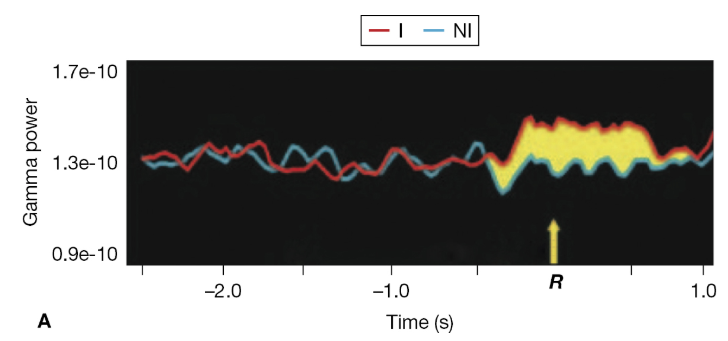
Incubation
Systematic studies show that this stage os often unreliable with incubation sometimes having no effect while other studies suggesting that incubation is more likely in circumstances where thoughts can wander which promotes spreading activation or when you are asleep.
Convergent vs divergent thinking
Convergent = Finding ways in which seemingly distinct ideas might be interconnected.
Divergent = Move one’s thoughts in novel and unanticipated directions i.e. generating new ideas
Stephen Wiltshire
An example of an autistic savant which is someone who has a low IQ indicated profound disability but is extremely talented in a certain domain. Wiltshire had near-perfect visual memory which led him to become a gifted artist.
Reliability
The degree of consistency with which a test measures a trait or attribute. Test-retest reliability is a measure that assesses whether the test results on one occasion are correlated with results at a later time i.e. are the results consistent over time.
Validity
The extent to which a method or procedure measures what it is supposed to measure which is assessed in many ways including predictive validity = an assessment that measures whether the test scores correlative with the relevant criterion or other test that measures the same thing.
Factor analysis
A statistical method for studying the interrelations among various tests. The goal is to discover the extent to which the tests are influenced by the same factors.
General intelligence
A mental capacity that is hypothesised as contributing to the performance of virtually any intellectual task. The existence of g is documented by the statistical overlap, usually revealed through factor analysis, among diverse forms of mental testing.
Fluid intelligence
The ability to deal with new and unusual problems. Reaches peak in early adulthood then declines across lifespan. More affected by alcohol, fatigue, and depression.
Crystallised intelligence
A person’s acquired knowledge, including their repertoire of verbal knowledge and cognitive skills. Increases with age and only declines at age 70 when persons overall condition starts to deteriorate. Highly correlated with fluid intelligence and vice versa.
Inspection time
The time a person needs to make a simple discrimination between two stimuli; used in some settings as a measure of mental speed, and then used as a way to test the claim that intelligent people literally are capable of faster processing in their brains.
IQ test (Binet)
A measure of intelligence that includes a range of task such as logic, abstract reasoning, learning ability, and working memory capacity. Test score was originally computed as a ratio between someones mental age (level of development reflected in test performance) and chronological age which was multiplied by 100
Wechsler Adult Intelligence Scale (WAIS)
A set of IQ tests that assess general knowledge, vocabulary, comprehension, perceptual-reasoning, working memory and processing speed
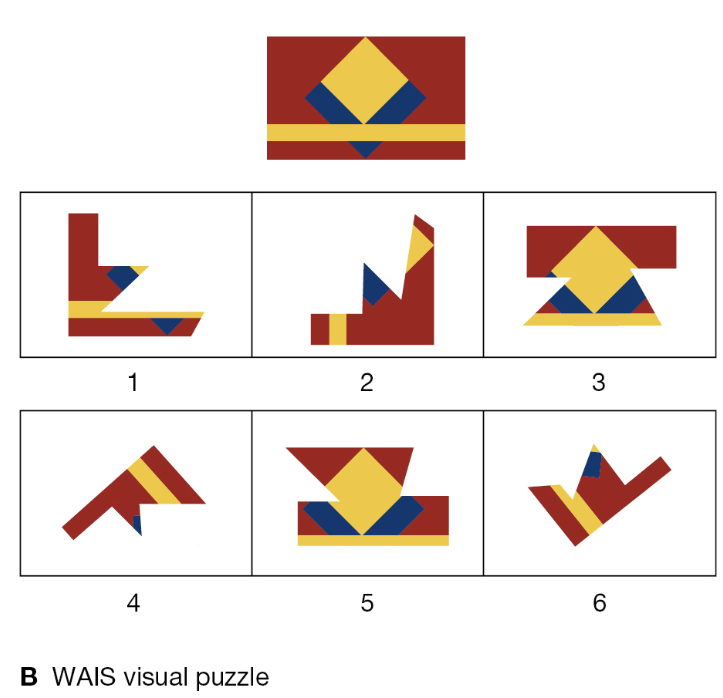
Raven’s Progressive Matrices test
Tests ability to analyse figures and detect patterns and is designed to minimise influence from verbal skills or background knowledge.
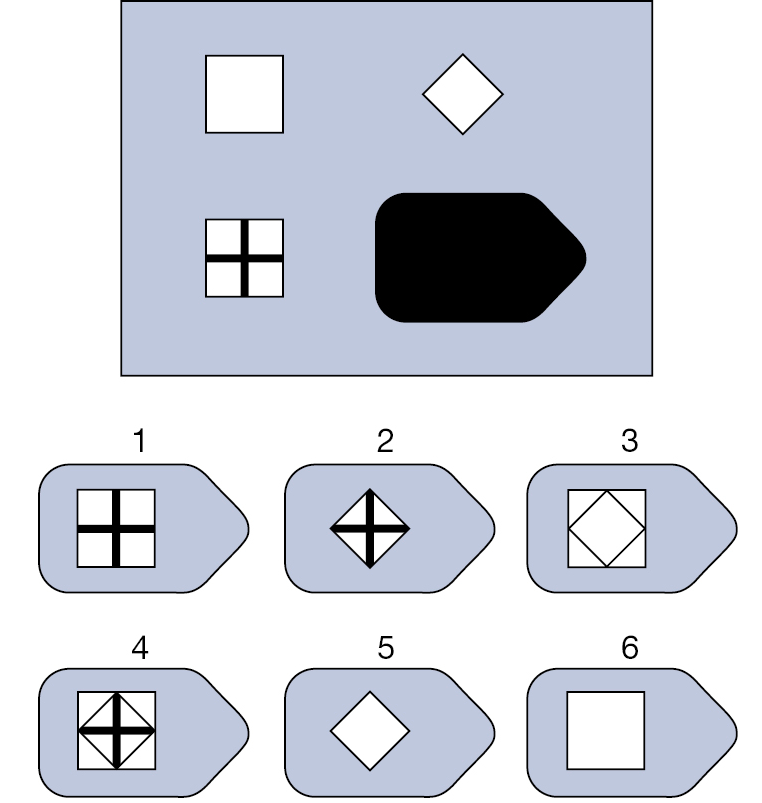
Reliability of IQ tests
IQ tests have strong test-retest reliability which allows researchers to accurately predict IQ at different ages and IQ is often constant but can change with substantial environment changes.
Validity of IQ tests
IQ does allow us to predict how well a person will do in settings that require intelligence. There is a correlation between a persons IQ and academic performance e.g. GPA, work performance (depending on the job with higher correlation for complex jobs that require more intelligence) and longevity. People w/ high IQ often have better careers and are less likely to suffer life problems, get into car-accidents and have difficulty following doctors instructions
Hierarchical model of intelligence
Demonstrates the people have an overall general intelligence that contributes to all tasks and then differing linguistic, numerical and spatial ability. Underneath these abilities are 80 specialised abilities. We will find correlations in performance across tasks e.g. verbal and arithmetic bc they both draw on g however we will have higher correlations on tasks within the same category bc they both draw on specialised capacities.
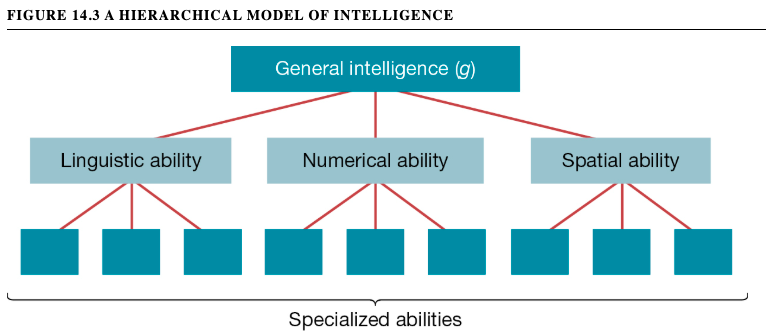
Dyslexia
A problem in reading despite normal intelligence. Diagnosis relies on the fact people often have an overall consistency in intellectual performance whereas people with dyslexia don’t have this consistency in reading areas.
Executive control proposal of intelligence
Working memory capacity is a measure of executive functioning and people with larger WMC do better at tests designed to measure g. Therefore, intelligence may be the ability to control ones thoughts. A related proposal is that g is a measure of combined operations that overlap in how they are used which involves executive control.
Practical intelligence
The ability to solve everyday problems through skilled reasoning that relies on tacit knowledge acquired through experience.
Emotional intelligence
The ability to understand one’s own and others’ emotions and to control one’s emotions appropriately.
Theory of multiple intelligences
A proposal that there are many forms of intelligence, linguistic, logical-mathematical, spatial, musical, bodily-kinesthetic (complex movement patterns), interpersonal (understanding others), intrapersonal (understanding ourselves) and naturalistic (ability to understand natural patterns)
Savant syndrome
A pattern of traits in a disabled person such that the person has some remarkable talent that contrasts with their very low level of general intelligence.